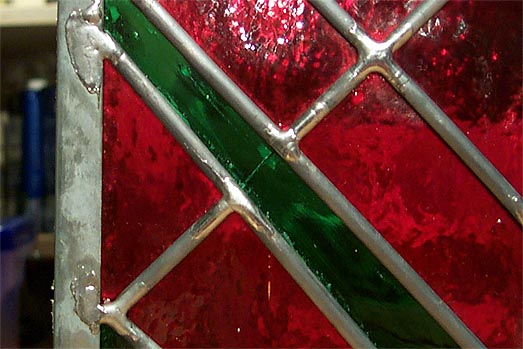 |
 |
 |
|
I'm learning the art (or is it a craft?) of stained glass. At this weblog, I record progress, note useful links, and document flesh wounds. Links
The Art League
Weisser Glass Studio
Virginia Stained Glass Co.
Warner-Crivellaro
Glass Galleries Links List
The StoreFinder: Stained Glass Store Front
ArtGlassArt.com Tutorials
rec.crafts.glass
Nancy's Beginner Tips and Tricks
Splinter Removal Tips
Syndicate this site
Archives
By Date
November 2006 October 2006 May 2006 June 2004 October 2003 September 2003 August 2003 June 2003 May 2003 April 2003 March 2003 February 2003 January 2003 December 2002 November 2002 October 2002 September 2002 By Project Beaded Unity Candle Crocus Panel Dogwood Windows Green Tiered Lamp Lilypads/Lotus Panel Transoms Xmas Ornament |
 |
November 06, 2002: Had To Happen Sooner or Later
Another milestone today: my first crack.

Sigh. It doesn't exist in the photos I took at the end of last night's class, so either it happened in transport on the way home, or it happened during today's ill-fated solder session. I had a hell of a time with it, and I don't know why. Particularly with the joints of lead came to the zinc framing: the solder would pool over on the zinc as if the lead had a force field around it. Plenty of solder flux, plus brand-new soldering iron: you tell me. Anyway, I have read that you can get cracks in your glass during soldering if you linger too long in one place with the hot iron. The radical shift in temperature---the soldering iron is 700 degrees F---can stress the glass and cause it to break. But I'd think I'd hear that---wouldn't I?---and too, the joints on either end of the break were pretty easy ones to solder. I also discovered, on the previously inaccessible back side of my panel, a dime-sized chip on the edge of another of my green pieces. It won't be very noticeable, visually speaking, but it is going to make me nervous forever... such places are excellent points for breakage at some point in the future, and the chip is big enough that I have a feeling that when or if the piece does break there, it won't be a nice neat hairline crack like the one in the photo above. I don't know. Too late to sweat these things now, for sure. I'm about 5/8 of the way through total soldering and there's no turning back now. Posted by Michelle on November 06, 2002 05:25 PM Comments
i used to do stained glass a few years back, and reading your site makes me miss it! your crack was probably due to the heat, as it happened on a little piece of glass, and the smaller the piece, the quicker it heats up. you can't always hear the crack, either. and regarding your patina: i'm sure you'll have no problem! it's hard to mess up that part. plus, that's the fun part, because you are almost done! keep up the great work! i am really enjoying watching your progress! -jmb. Posted by: jennifer baughan on November 6, 2002 06:42 PMHi Michelle, There is a way you can hide that crack if you want. I alluded to it when I first mentioned the "Dutchman" technique. Cut all of the heart out of some lead came so you have just the face left, then trim it to lie over the crack. If you like, try to make it look like an extension of the other came lines on the adjoining pieces. Solder both ends to the lead, and then convince yourself you meant to have a came line there anyway! Remember to do this on both sides. Apparently this is a common way for hiding small cracks: just make it look like it was part of the original design! Particularly on larger panels, nobody but the orginal artist would even notice a small detail like and extra line here or there. I would definitely notice though. Constantly. I dunno... maybe, maybe. The Dutchman trick is wonderful though. I'm taking a break from soldering right now and I've been down in the basement just snipping away at my tiny scraps of leftover lead. It definitely works out much better than trying to get the solder to join up across a 1/16" gap. Jennifer: good to know, about the small pieces cracking first. I'm now trying to work so that I don't do all the joints surrounding a small piece in a row, letting each one cool off completely before moving to the next. Thanks. Posted by: Michelle on November 7, 2002 12:48 PMComments are closed. Contact me via the email address at the bottom of the blog pages.
|
| Copyright © 2002-06 Michelle Kinsey Bruns. E-mail me at my first name at this domain. (Take that, spam spiders!)
|
||